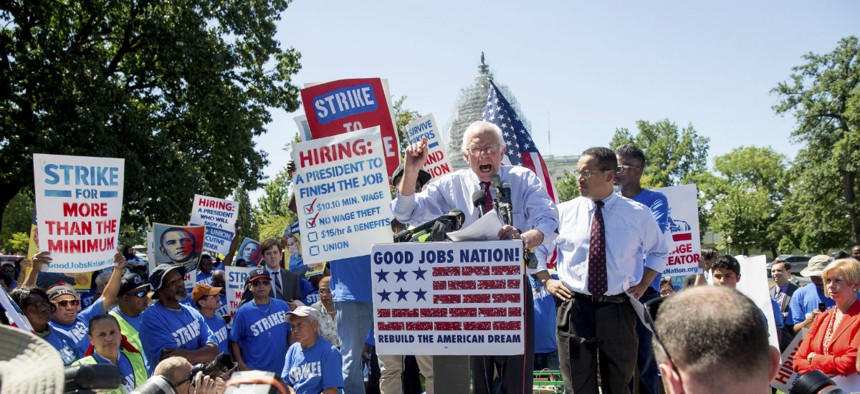
Democratic presidential candidate Sen. Bernie Sanders, I-Vt., joined by Rep. Keith Ellison, D-Minn., at right, and federal contract workers, speaks during a rally on Capitol Hill July 22 to push for a raise in the minimum wage. Andrew Harnik/Associated Press
Feds Earn 78% More Than Private Sector Workers, Study Finds
Cato Institute does not factor federal workers’ demographics or skill levels.
Federal employees on average earned 78 percent more in total compensation than private sector workers in 2014, according to a new study from a conservative think tank.
The Cato Institute’s Chris Edwards compared data from the Bureau of Economic Analysis to show that, in his view, civilian federal workers are overcompensated. Factoring both salary and benefits, Edwards pointed to BEA data showing the average federal employee earns about $119,000 annually, compared to the private sector worker who earns $67,000 per year. When comparing just salaries, feds collect 50 percent bigger paychecks, Edwards said.
The wage gap between the federal and private sectors has grown since the 1990s, Cato’s director of tax policy studies found. The divide has doubled since 1990, when it was just 39 percent. The growth, he said, came from not just raising pay levels and offering more generous benefits, but also a more “top-heavy” bureaucracy that routinely moves employees into higher salary brackets and redefines jobs as higher earning positions.
“The federal government has become an elite island of secure and high-paid employment, separated from the ocean of average Americans competing in the economy,” Edwards wrote in his findings.
The Cato study examines raw compensation data, and does not account for any fundamental differences in the demographics of the federal workforce or the work it does.
“I want to stress the importance of comparing apples to apples,” said Robert Goldenkoff, director of strategic issues at the Government Accountability Office and author of a 2012 report examining the federal-private pay gap, of the new study. “Federal employees tend to be better educated and work in jobs that require higher skill levels compared to non-federal jobs, so Cato's results comparing average wages of feds to other sectors are both not surprising and don't tell the whole story. More rigorous, sophisticated analysis is needed.”
Several efforts have been made at such analyses, comparing federal and private sector pay based either in job-related attributes or individuals' personal attributes. The Federal Salary Council, a group made up of union representatives and pay experts that advises the President’s Pay Agent, has consistently found federal workers are severely underpaid compared to the private sector. Other conservative think tanks, such as the American Enterprise Institute and the Heritage Foundation, found compensation favored feds, but by less than Cato’s findings. USA Today and the Project on Government Oversight both found a 20 percent gap in favor of federal workers, while the Congressional Budget Office has said the divide depends on education breakdowns of high school, bachelor’s degree or professional degree.
In its analysis, GAO said there is no perfect way for making the measurement. The Office of Personnel Management has attributed any gap to federal employees tending to be older and more experienced than the average private sector worker. This chart shows the various findings in recent studies, arranged from smallest to largest federal pay gaps.

In the Cato report, Edwards said groups representing federal employees have successfully blocked any significant reforms to their compensation structure.
“Federal workers are a powerful special-interest group, and they are effective lobbyists,” Edwards wrote. “Federal unions actively oppose legislators who support restraining worker pay.”
He added that it is not just “rocket scientists” who earn inflated salaries, but “regulator white-collar” employees as well. Feds enjoy the added benefit of better job protection than their private sector counterparts, Edwards said, and pointed to their lower “quit rate” as further evidence that they know they have it good.
“In the past, there was a view that it was a privilege for citizens to serve the public in a federal agency, and that federal pay should be fairly modest,” Edwards said. “Unfortunately, that sort of thinking has gone out the window as the federal compensation advantage has continued to increase.”







